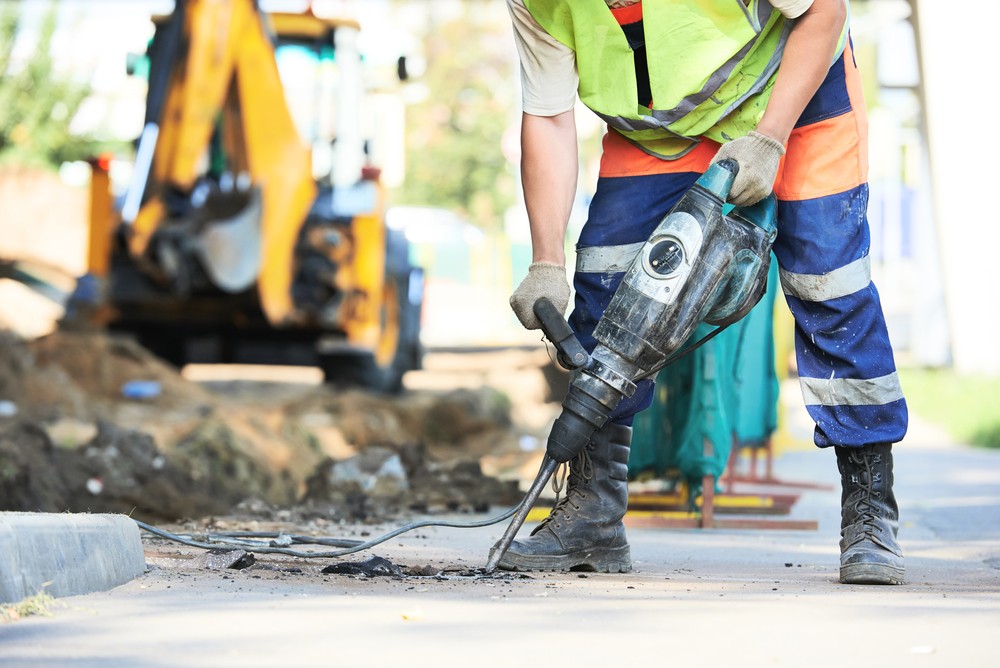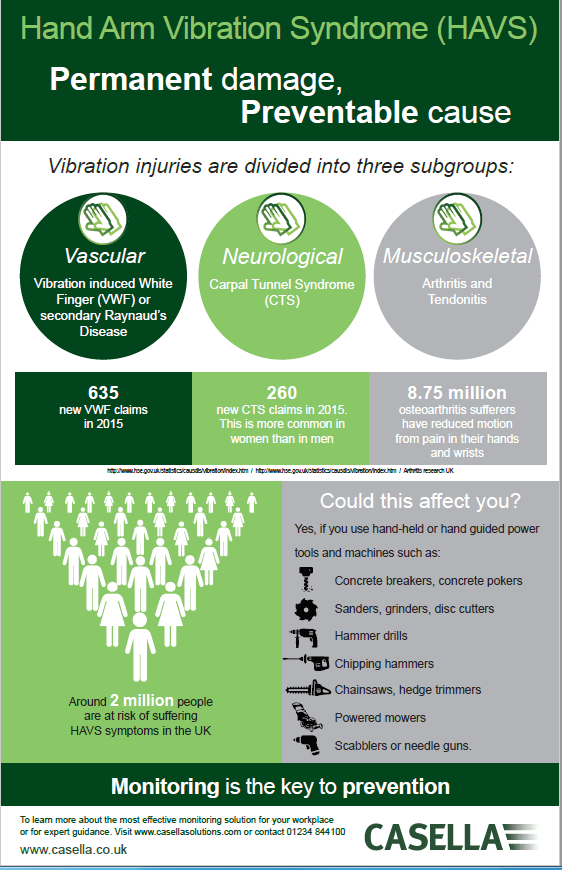
Hand Arm Vibration (HAV) syndrome is a big risk for workers across the UK. Tim Turney of Casella assesses how to prevent exposure in the workplace.
It is estimated nearly two million people in the UK are at risk of developing Hand Arm Vibration, commonly referred to as HAV syndrome.[1] Exposure to vibration in the workplace can lead to serious consequences, causing long-term injury or impairment.
HAV is transmitted into workers’ hands and arms from the use of hand-held power tools and hand guided equipment.[2] High risk sectors include construction, carpentry, ground maintenance, engineering, ship building and ship repairs where workers operate powerful tools, emitting high levels of vibration.
The health affects of vibration are permanent but the cause is preventable. Employers must act, implementing effective monitoring solutions to help prevent workers suffering life changing conditions.
Health
 The Control of Vibration at Work Regulations (2005) stipulate employers must limit and ultimately eliminate the risks of vibration by ensuring exposure is ‘low as reasonably practical’.[3]
The Control of Vibration at Work Regulations (2005) stipulate employers must limit and ultimately eliminate the risks of vibration by ensuring exposure is ‘low as reasonably practical’.[3]
If workers are not provided with the right equipment or vibration levels are not being appropriately monitored, there could be serious repercussions. The health issues, often with agonising symptoms, are divided into three subgroups below:
- Vibration White Finger (Raynaud’s disease) – This is a vascular disorder caused by the restricted blood flow, causing visible blanching of the hands[4]. In 2015, 635 new claims were made.[5]
- Neurological Vibration (Carpel Tunnel Syndrome) –This problem causes tingling and numbness in the fingers with a lack of dexterity and in 2015, 260 new claims of workers suffering from this syndrome were made.[6]
- Muscle and Soft Tissue Damage – Such as arthritis, changes to muscles and tendonitis, which can result in loss of grip strength
These conditions are particularly debilitating and could lead to financial and social implications, limiting an individual’s ability to work and socialise. In 2000, eight former employees of North West Water were awarded £1.2m compensation after they contracted Vibration White Finger at work.
The men from Merseyside stopped working for the company in 1998 when they developed symptoms including loss of feeling, loss of grip, bleeding fingers and constant pain – highlighting how damaging the exposure really can be. [7]
To avoid companies and workers suffering the harmful affects of vibration, employers should conduct regular risk assessments of the workplace. Implementing assessments will ensure changes are productive and the hand tools and machinery are safe to use.[8]
Failure to carry out risk assessments could lead to serious health problems of workers and detrimental implications for employers. An ongoing monitoring programme is vital to ensure standards are adhered to and that accurate evidence is collated.
Monitoring
Different jobs emit different levels of vibration; cutting brick will create different levels to cutting wood. Irrespective of the task, employers must adhere to the government standards of safety that stipulates the daily exposure limit for vibration (ELV) is 5 m/s2. This value is the maximum level of vibration an employee can be exposed to on any single day and above that employees should not continue until steps have been taken to reduce exposure.[9]
Employers must also focus on the daily exposure value (EAV), which should not exceed 2.5 m/s2. Employers should take the necessary control measures, ensuring exposure is reduced below this value as far as is reasonably practicable.
High powered tools are now designed with estimated vibration levels and employers should use this as a guide, indicating how long workers can operate these for.[10]
Measuring the vibration levels, extends this, actually measuring exposure. This is essential, measuring the vibration levels of tools not just when the tools are new, but as their vibration levels deteriorate with time.
Monitoring gives employers the knowledge that tools and machinery continue to be safe for use after purchase, helping to ensure worker productivity and safety. When manufactured, all monitoring devices should adhere to the standard ISO8041. The data monitoring provides could shape further education campaigns, highlighting areas where further training is required, ensuring employees are completely aware of the issues.
Moving forward
In a busy industrial sector, operating dangerous tools is an essential part of the job, and continues to be a daily task for workers. Monitoring provides valuable information to reduce and prevent risks.
Without monitoring, health could be at risk and workers might end up suffering from the damaging consequences for the rest of their life. Employers must implement change, taking action now.
Tim Turney is technical product manager at Casella
References:
[1] http://www.hse.gov.uk/vibration/hav/index.htm
[2] http://www.hse.gov.uk/pubns/indg175.pdf
[3] http://www.hse.gov.uk/vibration/hav/regulations.htm
[4] http://www.vibrosense.eu/knowledge-bank/medical-background/hand-arm-vibration-injuries
[5] http://www.hse.gov.uk/statistics/causdis/vibration/index.htm
[6] http://www.hse.gov.uk/statistics/causdis/vibration/index.htm
[7] http://news.bbc.co.uk/1/hi/uk/879922.stm
[8] http://www.hse.gov.uk/pubns/priced/l140.pdf
[9] http://www.hse.gov.uk/pubns/priced/l140.pdf
[10]https://books.google.co.uk/books?id=yNfQrXnjkKUC&pg=PA239&dq=Hand+arm+vibration+in+the+workplace+journals&hl=en&sa=X&ved=0ahUKEwiy1JSvtq7UAhWEchQKHQafCWgQ6AEIIjAA#v=onepage&q&f=false
What makes us susceptible to burnout?
In this episode of the Safety & Health Podcast, ‘Burnout, stress and being human’, Heather Beach is joined by Stacy Thomson to discuss burnout, perfectionism and how to deal with burnout as an individual, as management and as an organisation.
We provide an insight on how to tackle burnout and why mental health is such a taboo subject, particularly in the workplace.



